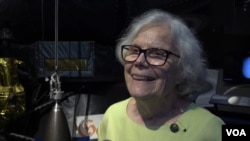Sue Finley, now 80 years old and NASA’s longest-serving female employee, recalls her early days with the space agency when she worked as a human “computer,” calculating rocket trajectories by hand at a time when computers were huge and expensive to operate.
Finley arrived at Jet Propulsion Laboratory (JPL) in Pasadena, California, in January 1958, one week before the U.S. Army launched Explorer 1, America's first earth satellite.
“It was a very big deal,” she recalls of the launch, a response to the launches a few months earlier of the first satellites, Sputnik 1 and 2, from the former Soviet Union.
She was at JPL for Pioneer 1, the first satellite sent aloft by the newly formed National Aeronautics and Space Administration (NASA) in late 1958, which marked the beginning of the international space race.
Unmanned space probes
Since then, Finley has had a role in nearly every U.S. unmanned space probe, and some missions of other nations.
There were failures to overcome and spectacular successes, but always new goals as scientists expanded our knowledge of the earth and solar system.
“We were certainly proud,” she says of NASA accomplishments, “but you just go onto the next thing.”
Finley has been through several career changes with the space agency, one of the most important when NASA phased out human computers, moving, initially, to simple electronic versions.
“We got little tiny computers,” she recalls. “One I had 16 wires, jumper cables to code with. One had 10 pegboards that you programmed with.”
As modern computers took over navigational tasks, Finley developed and tested software as a subsystem engineer.
Among her career highlights: the Vega mission, a Soviet-French collaboration to Venus, and Halley’s Comet, which received navigational help from NASA and dropped balloons into the atmosphere of Venus.
She had to change the software for the antenna that tracked the mission, “and it worked,” Finley recalls. “Everything worked. That's what was so exciting!”
Finley has worked since 1980 on NASA’s Deep Space Network, which coordinates satellite facilities in California, Spain and Australia that allow communication with space probes.
Highlights of NASA career
Career highlights include developing software that generates audio tones sent back from spacecraft, informing engineers on the ground what is happening in space. It was first developed for the Mars missions.
Each tone has a meaning that communicates data, noted one of Finley’s colleagues, Stephen Lichten.
“If a parachute opened, it would send a tone,” Lichten, manager for special projects for the Deep Space Network, said.
“The spacecraft lets go of its heat shield, and it would send a different tone, and so engineers like Sue were here listening for those special frequencies which told them the spacecraft was telling them what it has just done,” he said.
He notes that Finley also helped develop communication arrays that combine multiple antennas to act in unison, and other advances that now crucial to space missions.
Lichten once shared an office with Finley and says she inspired her younger colleagues.
“There was a parade of people coming in constantly, to ask her advice, to ask her questions,” he recalls. “This was during the Venus balloon mission days and I realized that Sue was regarded as sort of a guru at JPL.”
Finley has been involved with nearly every advance in space communications in recent decades, and she continues her work today, Lichten said.
There are many more women at NASA today than there were when she started, and Finley said she tells young women to be inquisitive.
“I tell them to never be afraid to ask questions, never be afraid to say you don't know,” she said.
After nearly six decades at the space agency, a mother of two grown sons and a mentor to her colleagues, Finley has no plans of retiring.
“There's nothing else I want to do,” she said. “And so far, they need me.”
As they have since the earliest days of the space agency.









